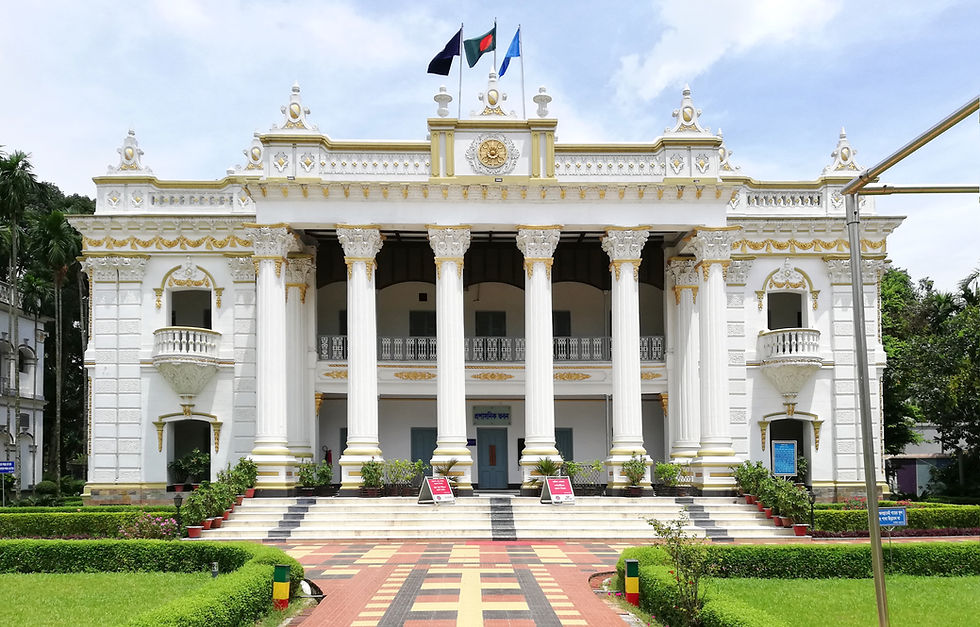Ratargul Swamp Forest: A Hidden Water Wonderland of Sylhet
- Niharika Momtaz

- Aug 21
- 4 min read

Once you step off the main road and onto the narrow earthen track, Ratargul Swamp Forest feels like a scene pulled straight from a fantasy film. Locals sometimes call it the Amazon of Bangladesh, and the nickname fits because the whole place looks as if someone painted quiet lagoons between the trees. On rainy days or in winter mist, the water keeps turning different shades of blue-green, and visitors never quite see the same forest twice.
A Rare Gem in Bangladesh's Wilderness
The swamp sits roughly 26 kilometers from Sylhet city, just beside the sluggish Gowain River in Gowainghat Upazila. Stretching over 3,300 acres in total, the heart section is protected as a wildlife sanctuary and covers 504 acres on the park's official maps. Folk wisdom says the forest borrowed its name from the local rata or pati tree, whose wide roots appear to sketch little islands whenever the floodwaters drop.
A Landscape Shaped by Water
The real charm of Ratargul comes from its close dance with water. For four to seven months each year, mainly from May to October, the forest sits under 20 to 30 feet of rain-fed water. Old trunks sink out of sight, and their leafy tops arch over the mirror-smooth surface. Once the skies dry, the lake drops back to about 10 feet, laying bare roots and reeds and flipping the view upside down.
Ratargul pumps life from the nearby Gowain River and drinks runoff from Meghalaya's misty hills. In the monsoon, the woods turn into a maze of half-submerged trunks and pencil-thin channels that only a small canoe can thread. When the rains pack up, gravel paths reveal themselves, leaves pile up like confetti, and what were once waterways become shoed-friendly alleys.
A Sanctuary of Biodiversity
Get ready for a green hug. Ratargul feels like stepping straight into a live nature documentary. Water-loving trees-Koroch, Hijal, Barun, Cane, and Murta-huddle together above your head, blocking out most of the sky. Under that leafy umbrella, more than 25 kinds of wetland plants raise roots and reeds that feed hiding insects, small mammals, and just about anything else looking for a snack.
Listen closely, and you can almost hear the forest breathing. Flashy kingfishers dart past while stately herons freeze for a timeless moment. Schools of silvery fish slip below the surface, and tree branches double as a sunbathing ledge for snakes and lizards. Mix those sights and sounds together, and you end up with a living soundtrack that no earbud playlist could ever match.
A Journey into the Tranquility of Ratargul Swamp Forest
The trip to the Ratargul swamp begins the moment you leave buzzing Sylhet city. First, a dusty road carries you to Gowainghat, and then a small boat follows twisting water lanes until the forest opens up. Time seems to stretch once you're inside. Paddle slowly so the only sound is your own breath. Sunlight spears through the leaves and dances across the mirror-flat water.
Monsoon season is when the sweet spot trunk and root disappear under deep, inky liquid, and the swamp is at its most photogenic. There is no cellphone ping here, just you, a few dragonflies, and the quiet hum of a place that feels as old as Bangladesh itself.
A Treasure to Protect
Ratargul Swamp Forest is more than a pretty postcard; it acts like the lungs of the region, soaking up floodwaters and cleaning the air. Every heron, water lily, and whispering breeze counts in that balance, and keeping the forest safe means keeping those tiny miracles alive for the kids who haven't even arrived yet. Whether you're framing shots for Instagram, ticking off rare birds in a notepad, or simply soaking in the scenery, this spot gifts memories that linger long after the boat ride home.
Ratargul Swamp Forest sits just outside Sylhet City, Bangladesh, and greets visitors with its maze of mangrove trees hovering over dark, mirror-like water. These wetlands feel almost like scenes ripped from a low-budget nature film, but the place is surreal and quiet in real life.
Boats slide through the narrow canals, their wooden hulls slicing the glassy surface while water hyacinths drift lazily aside. A few crew members toss breadcrumbs, and the sudden splash of fish breaking the surface makes you cool-headed for a second, then grin the next.
Local guides usually steer tourists toward a lookout point where the canopy suddenly opens up. From that perch, the roots look like thick octopus arms propped against a staring sky, and the colors shift as sunlight flickers between the branches.
Most cell phones snap photos better than the human eye really catches it, yet people still try because the swamp has a way of showing motion even when the camera sensor is frozen. Critics sometimes call it touristy, but they admit the lighting is cheap, with free mood lighting.
The best time to visit is shortly after heavy rain when floodwaters swell the channels and give the boatmen bragging rights for 'extra inches.' Crowds thin out on weekdays, so a Thursday or early Friday feels almost personal, like the forest stretches a welcome mat just for you.
Birdwatchers swear they spot kingfishers here that flash the same teal as a forgotten soda can, and people who never look up keep stepping aside for a heron that glides by like an overqualified taxi driver. Nature strikes its odd bargains.
Another reason the swamp stays on tourists' maps is simple: no internet is required once you're paddling. That silence carries a kind of company no playlist can create, and, believe me, battery lights blink off faster than you expect.
Videos on YouTube give a rough idea, but watching pixel water ripple is cheating, like reading about ice cream instead of tasting it. The local tourism board even dropped a drone clip to lure younger crowds; honestly, it worked.




Comments